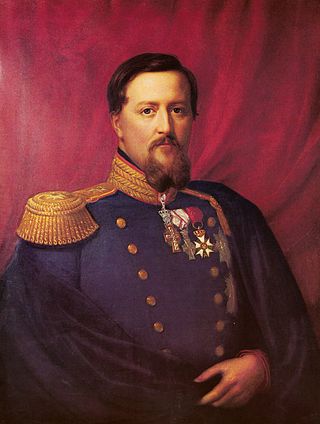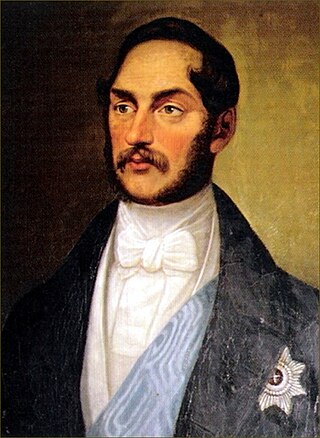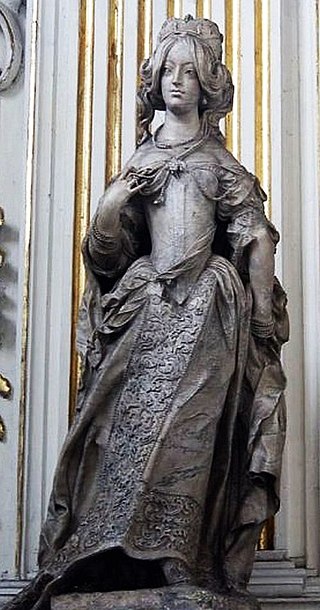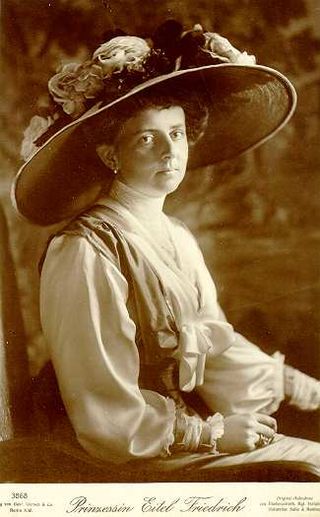
Christian IX was King of Denmark from 15 November 1863 until his death in 1906. From 1863 to 1864, he was concurrently Duke of Schleswig, Holstein and Lauenburg.

Frederick VII was King of Denmark from 1848 to 1863. He was the last Danish monarch of the older Royal branch of the House of Oldenburg and the last king of Denmark to rule as an absolute monarch. During his reign, he signed a constitution that established a Danish parliament and made the country a constitutional monarchy. Frederick's motto was Folkets Kærlighed, min Styrke.

Christian I was a German noble and Scandinavian monarch under the Kalmar Union. He was king of Denmark (1448–1481), Norway (1450–1481) and Sweden (1457–1464). From 1460 to 1481, he was also duke of Schleswig and count of Holstein. He was the first king of the House of Oldenburg.

Frederick VIII, Duke of Schleswig-Holstein and of Schleswig-Holstein-Sonderburg-Augustenburg was the German pretender to the throne of second duke of Schleswig-Holstein from 1863, although in reality Prussia took overlordship and real administrative power.

Princess Marie Louise of Schleswig-Holstein was a granddaughter of Queen Victoria.

Friedrich Wilhelm, Duke of Schleswig-Holstein-Sonderburg-Glücksburg was a German-Danish prince and officer who was the Duke of Schleswig-Holstein-Sonderburg-Beck from 1816 to 1825, and the Duke of Schleswig-Holstein-Sonderburg-Glücksburg from 1825 to 1831. Friedrich Wilhelm is the progenitor of the House of Glücksburg.

Prince Christian of Schleswig-Holstein was a minor Danish-born German prince who became a member of the British royal family through his marriage to Princess Helena of the United Kingdom, the fifth child and third daughter of Queen Victoria and Prince Albert of Saxe-Coburg-Gotha.

Holstein-Gottorp is the historiographical name, as well as contemporary shorthand name, for the parts of the duchies of Schleswig and Holstein, also known as Ducal Holstein, that were ruled by the dukes of Schleswig-Holstein-Gottorp, a side branch of the elder Danish line of the German House of Oldenburg. Other parts of the duchies were ruled by the kings of Denmark.

Augusta Viktoria of Schleswig-Holstein was the last German Empress and Queen of Prussia by marriage to Wilhelm II, German Emperor.

Grimm's Fairy Tale Classics, also known as Grimm Masterpiece Theater in the original version and The Grimm's Fairy Tales, is a Japanese anime anthology series by Nippon Animation based on the Grimms' Fairy Tales.

Charles Frederick, Duke of Schleswig-Holstein-Gottorp was a Prince of Sweden and Duke of Schleswig-Holstein-Gottorp and an important member of European royalty. His dynasty, the Dukes of Schleswig-Holstein-Gottorp, were a cadet branch of the ancient House of Oldenburg, which at that time was ruling Denmark-Norway. His mother was a sister of Charles XII of Sweden. Charles Frederick married a daughter of Peter the Great and became the father of the future Peter III of Russia. As such, he is the progenitor of the Russian imperial house of Holstein-Gottorp-Romanov and the patrilineal ancestor of all Russian emperors starting with Peter III, except for Catherine II.

Dietrich or Theoderic of Oldenburg was a feudal lord in Northern Germany, holding the counties of Delmenhorst and Oldenburg. He was called "Fortunatus", as he was able to secure Delmenhorst for his branch of the Oldenburgs.
The kitsune no yomeiri is a term or metaphor for certain natural phenomena, or a folk belief regarding a supernatural event, in Honshu, Shikoku, and Kyushu. The term "kitsune no yomeiri" can refer to several things: atmospheric ghost lights, in which it appears as if paper lanterns from a wedding procession are floating through the dark; sunshowers; or various other phenomena that may resemble wedding processions and are referenced in classical Japanese kaidan, essays, and legends. The kitsune no yomeiri is always closely related to foxes, or kitsune, who often play tricks on humans in Japanese legend; various Shinto rituals and festive rites relating to the kitsune no yomeiri have been developed in various parts of Japan.

August Philipp, Duke of Schleswig-Holstein-Sonderburg-Beck was a Danish-German prince and member of the House of Oldenburg. After acquiring the estate of Beck in Westfalen in 1646, he took the title of Duke of Schleswig-Holstein-Sonderburg-Beck.

Frederick Christian II, Duke of Schleswig-Holstein-Sonderburg-Augustenburg was a Danish prince and feudal magnate. He held the island of Als and some other castles in Schleswig.
Dorothea of Schleswig-Holstein-Sonderburg-Beck, known also as Dorothea von Holstein-Beck and Dorothea von Ziedewitz,, was a German princess of the House of Oldenburg and by marriage Margravine of Brandenburg-Bayreuth-Kulmbach.

Karl, Duke of Schleswig-Holstein-Sonderburg-Glücksburg was Duke of Schleswig-Holstein-Sonderburg-Glücksburg from 1831 to 1878. Karl was the eldest son of Friedrich Wilhelm, Duke of Schleswig-Holstein-Sonderburg-Glücksburg, and Princess Louise Caroline of Hesse-Kassel and an elder brother of Christian IX of Denmark.

The monarchy of Denmark is a constitutional institution and a historic office of the Kingdom of Denmark. The Kingdom includes Denmark proper and the autonomous territories of the Faroe Islands and Greenland. The Kingdom of Denmark was already consolidated in the 8th century, whose rulers are consistently referred to in Frankish sources as "kings". Under the rule of King Gudfred in 804 the Kingdom may have included all the major provinces of medieval Denmark.

Karolina of Legnica-Brieg-Wohlau, was a Silesian noble, duchess of Legnica, Brzeg and Wołów and the last member of the Silesian Piasts dynasty. She was the eldest daughter of Christian, Duke of Brieg and Louise of Anhalt-Dessau. After the death of her father, she married secretly without the knowledge of her mother on 14 July 1672 to Duke Frederick von Schleswig-Holstein-Sonderburg-Wiesenburg and also became the duchess of Schleswig-Holstein-Sonderburg-Wiesenburg.

Duchess Sophia Charlotte of Oldenburg was a member of the House of Holstein-Gottorp. She was the only surviving child of Frederick Augustus II, Grand Duke of Oldenburg by his first wife Princess Elisabeth Anna of Prussia.



















